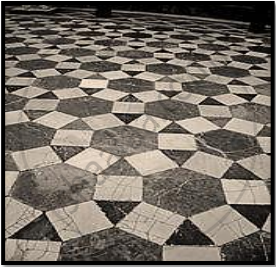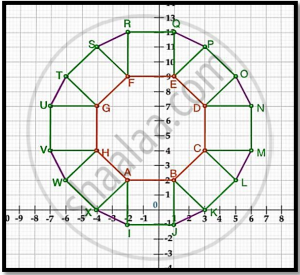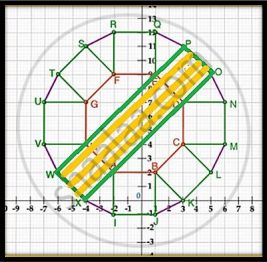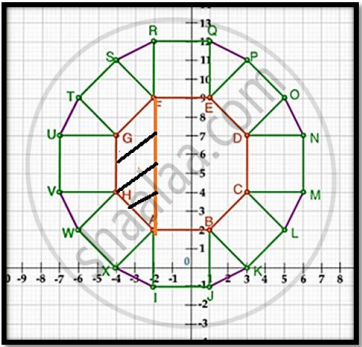Advertisements
Advertisements
Question
A tiling or tessellation of a flat surface is the covering of a plane using one or more geometric shapes, called tiles, with no overlaps and no gaps. Historically, tessellations were used in ancient Rome and in Islamic art. You may find tessellation patterns on floors, walls, paintings etc. Shown below is a tiled floor in the archaeological Museum of Seville, made using squares, triangles and hexagons.

A craftsman thought of making a floor pattern after being inspired by the above design. To ensure accuracy in his work, he made the pattern on the Cartesian plane. He used regular octagons, squares and triangles for his floor tessellation pattern

Use the above figure to answer the questions that follow:
- What is the length of the line segment joining points B and F?
- The centre ‘Z’ of the figure will be the point of intersection of the diagonals of quadrilateral WXOP. Then what are the coordinates of Z?
- What are the coordinates of the point on y-axis equidistant from A and G?
OR
What is the area of Trapezium AFGH?
Solution
i. B(1, 2), F(–2,9)
BF2 = (–2 –1)2 + (9 – 2)2
= (–3)2 + (7)2
= 9 + 49
= 58
So, BF = `sqrt(58)` units
ii.

W(–6, 2), X(–4, 0), O(5, 9), P(3, 11)
Clearly, WXOP is a rectangle
The point of intersection of the diagonals of a rectangle is the midpoint of the diagonals. So the required point is the mid point of WO or XP.
= `((-6 + 5)/2, (2 + 9)/2)`
= `((-1)/2, 11/2)`
iii. A(–2, 2), G(–4, 7)
Let the point on y-axis be Z(0, y)
AZ2 = GZ2
(0 + 2)2 + (y – 2)2 = (0 + 4)2 + (y – 7)2
( 2)2 + y2 + 4 – 4y = (4)2 + y2 + 49 – 14y
8 – 4y = 65 – 14y
10y = 57
So, y = 5.7
i.e. the required point is (0, 5.7)
OR

A(–2, 2), F(–2, 9), G(–4, 7), H(–4, 4)
Clearly GH = 7 – 4 = 3 units
AF = 9 – 2 = 7 units
So, height of the trapezium AFGH = 2 units
So, area of AFGH = `1/2`(AF + GH) × height
= `1/2`(7 + 3) × 2
= 10 sq.units
APPEARS IN
RELATED QUESTIONS
In Fig. 14.36, a right triangle BOA is given C is the mid-point of the hypotenuse AB. Show that it is equidistant from the vertices O, A and B.

We have a right angled triangle,`triangle BOA` right angled at O. Co-ordinates are B (0,2b); A (2a, 0) and C (0, 0).
Prove that the points (3, 0), (4, 5), (-1, 4) and (-2, -1), taken in order, form a rhombus.
Also, find its area.
Find the coordinates of the point where the diagonals of the parallelogram formed by joining the points (-2, -1), (1, 0), (4, 3) and(1, 2) meet
In what ratio does the point P(2,5) divide the join of A (8,2) and B(-6, 9)?
In what ratio is the line segment joining the points A(-2, -3) and B(3,7) divided by the yaxis? Also, find the coordinates of the point of division.
If the point C(k,4) divides the join of A(2,6) and B(5,1) in the ratio 2:3 then find the value of k.
Find the ratio in which the line segment joining the points A(3, 8) and B(–9, 3) is divided by the Y– axis.
Points (−4, 0) and (7, 0) lie
If the point \[C \left( - 1, 2 \right)\] divides internally the line segment joining the points A (2, 5) and B( x, y ) in the ratio 3 : 4 , find the value of x2 + y2 .
Find the value of a for which the area of the triangle formed by the points A(a, 2a), B(−2, 6) and C(3, 1) is 10 square units.
If the points A(−2, 1), B(a, b) and C(4, −1) ae collinear and a − b = 1, find the values of aand b.
If points Q and reflections of point P (−3, 4) in X and Y axes respectively, what is QR?
If (x , 2), (−3, −4) and (7, −5) are collinear, then x =
If the centroid of a triangle is (1, 4) and two of its vertices are (4, −3) and (−9, 7), then the area of the triangle is
If points A (5, p) B (1, 5), C (2, 1) and D (6, 2) form a square ABCD, then p =
Find the point on the y-axis which is equidistant from the points (5, −2) and (−3, 2).
What are the coordinates of origin?
Students of a school are standing in rows and columns in their playground for a drill practice. A, B, C and D are the positions of four students as shown in figure. Is it possible to place Jaspal in the drill in such a way that he is equidistant from each of the four students A, B, C and D? If so, what should be his position?
The points (–5, 2) and (2, –5) lie in the ______.
The distance of the point (3, 5) from x-axis (in units) is ______.
